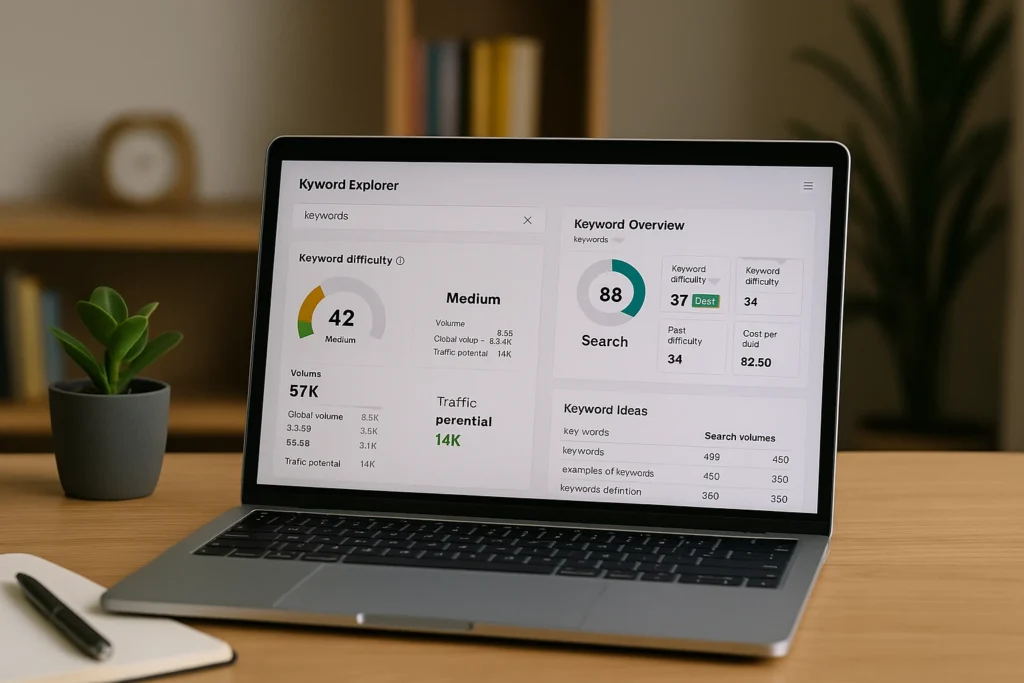Search Engine Optimisation (SEO) keyword research is easier than you might think. You need to find and study the exact search terms your target audience uses online. This process drives SEO success because it connects your content to what people actually search for.
Despite AI advances, keyword research remains the foundation of successful SEO strategies. Companies that invest in smart keyword research see 50% more traffic after 6 to 8 months compared to those who skip this step.
Search engines still need to understand what your content covers. The right SEO keywords tell them exactly that.
In this guide, we’ll explore proven tools, step-by-step processes, and strategies that drive real results. Let’s start by understanding what makes every keyword strategy work.”
Understanding What People Search For
We see this mistake happen with search terms all the time. Many marketers focus on what they want to say instead of what people really need to find. This means they write about their products without thinking about what their audience wants to know.
When you ignore what people actually search for, you miss out completely. Search intent decides if your content turns visitors into customers or sends them away.
Identifying search intent is not complicated when you know the four main types. Each type tells you exactly what kind of content people expect to see.
The 4 Types of Search Intent That Drive Traffic
The four main search intent types include:
- Informational intent: People want to learn something or find answers to their questions.
- Navigational searches: Users already know which specific website they want to visit.
- Commercial investigation: Research happens when someone compares options before making buying decisions.
- Transactional intent: This shows someone is ready to purchase or take action right now.
When someone searches “buy running shoes,” they’re ready to purchase (transactional). But “how to choose running shoes” signals they need information first (informational).
The fact is, those who succeed in recognising these patterns create content that matches what searchers expect to find.
How to Read Intent Clues from Search Results
Google search results reveal intent immediately. Believe it or not, you can tell what people want just by looking at what appears on page one. Generally, product pages dominating results indicate commercial intent, while how-to guides suggest informational searches. Once this pattern becomes clear, you’ll know exactly what type of content to create.
Why Matching Content to User Needs Works
The most successful pages answer the specific question behind each search query. For example, someone searching “laptop overheating fix” wants step-by-step solutions, not laptop shopping recommendations. If you don’t match intent, even perfect keyword research won’t save your rankings from disappointed visitors who bounce right back to Google search.
We have covered the foundation of understanding people’s intent. Now, let’s explore the right tools to find profitable keywords efficiently.
Best Keyword Research Tools Worth Your Investment

In practice, the right keyword research tools can transform your entire SEO approach. But how? The answer is simple. The right platforms turn hours of manual work into minutes of strategic insights. This happens because quality keyword research tools provide data that would be impossible to gather manually.
Sit tight as we explore some commonly used tools by successful SEO experts:
Free Tools That Deliver Real Value
- Google Keyword Planner: Your search volume data comes straight from Google’s database. You can access this through any Google Ads account, even without running campaigns.
- Ubersuggest: A popular platform known to offer 3 free searches daily with keyword difficulty scores that help you avoid impossible competition.
- Answer The Public: A must-try tool! Questions people ask about your topics appear here, giving you content ideas beyond basic keyword lists.
These free keyword tools offer a solid foundation for small businesses just starting their SEO efforts.
Premium Options Worth the Investment
- Ahrefs: The most comprehensive keyword data available lives on this platform. Ahrefs includes competitor analysis and content gap identification that shows you exactly what your competitors rank for.
- SEMrush: Also known as the all-in-one tool. SEMrush is a combination of keyword research, rank tracking, and site audits combined in one powerful platform.
- Moz Pro: Beginner-friendly interfaces make complex keyword data easy to understand without overwhelming complexity.
Our experience testing these platforms shows that free tools are effective for basic research, but premium options become essential when managing multiple websites. With your toolkit ready, here’s the exact process that delivers results.
Step-by-Step Keyword Research Process That Works

Every successful keyword strategy starts with understanding your audience’s language. Let’s be honest here, a systematic approach eliminates guesswork and maximises your chances of ranking for terms that bring qualified traffic to your website.
Follow these seven proven steps to build your keyword foundation:
- Seed keywords: The initial step is to write down the main topics your business covers and the words your customers use when talking about your products or services.
- Expand your initial keyword list: Take your focus keywords and run them through Google Keyword Planner or other keyword tools to discover related terms and variations.
- Search intent analysis: Once you have run your seed keywords through a keyword tool, the next step is to check what type of content appears in search results. The insight from it will help you understand what searchers expect when they use specific keywords.
- Competition levels need careful evaluation: You are halfway through. Now, use keyword difficulty scores to identify which terms you can realistically rank for based on your website’s authority.
- Search volume and trends: We are not done shortlisting your keyword list. In this step, you need to focus on keywords with consistent search volume that align with your business goals and seasonal patterns.
- Relevant keywords belong in topic groups: For better results, organise your keyword list into clusters that can be targeted together on single pages or blog posts.
- Opportunity scores determine your priorities: Calculate which keywords offer the best balance of search volume, low competition, and high relevance to your business.
Complete walkthrough templates and real examples help you implement each step without missing important details that could impact your results.
Finding Hidden Opportunities with Long Tail Keywords
While your competitors fight over “SEO,” smart marketers get much more traffic with longer, specific phrases. Long tail keywords show untapped opportunities with higher conversion rates. They target people who know exactly what they want.
We know what you are wondering: these longer phrases may have lower search volume, but they make up for it with better targeting. If we put a real example, a local bakery ranking for “gluten-free wedding cakes downtown Chicago” will convert far better than one competing for “wedding cakes.”
Also, voice search keeps growing, and people now ask complete questions instead of typing short phrases. This creates more opportunities for businesses that understand this shift.
But wait, there’s more to it. Long tail keywords work because they match how your customers think and speak.
One small business owner told us how switching from broad terms to specific phrases changed results completely. Instead of competing against major companies, this approach focused on serving specific customer needs. Within months, both organic traffic and leads went up dramatically.
Why does this happen? Specific searches show higher purchase intent from people ready to take action. Less competition plus higher intent equals better ROI for your content efforts. Now that you’ve found these golden opportunities, let’s determine which ones deserve your attention first.
How to Analyse Keywords for Maximum Impact

Most people skip keyword analysis completely, which leads to months of wasted content creation. Proper keyword evaluation saves time by helping you focus on opportunities that drive real results for your business.
Use these three evaluation methods to separate winners from time-wasters:
The Opportunity Score Calculation Method
Opportunity scores help you compare different keywords objectively. This simple math combines search volume, keyword difficulty, and business relevance into one number. Take your monthly search volume and multiply it by how relevant the keyword is to your business (rate this 1-10). Then divide that result by the keyword difficulty percentage.
Once you get your results, keywords scoring above 50 deserve immediate attention. On the other hand, scores below 20 indicate you should skip them entirely.
Competition Analysis Made Simple
Look at the top 10 search results for each target keyword. Next, count how many results come from major websites with high domain authority. If more than 7 results show established competitors, you should consider targeting related long-tail variations instead.
The reason is simple: look for gaps where smaller sites rank well, as these indicate opportunities you can capture.
When to Target vs When to Skip
Trust the process. Now, target keywords where you can provide better, more comprehensive content than the current ranking pages. However, skip terms where established authorities dominate with high-quality, in-depth resources. Instead, focus on keywords where search results show mixed content quality or outdated information that you can improve upon.
We recommend that you invest 20% more time analysing upfront so that you save 80% more time creating content that ranks and converts visitors into customers.
Putting Your Keyword Strategy to Work
Take your breath now because we have covered it all. It’s time for you to turn those insights into content that ranks. This step determines whether keywords become actual visitors or just unused data.
Your content calendar should organise around the keyword groups you found. Long-tail keywords deserve your attention first since they rank faster and build momentum for bigger terms.
Remember, content types need to match what searchers expect. This way, blog posts work for people seeking information, while product pages serve buyers on Google search. Each piece should match the intent behind your target keywords.
Many people don’t realise this: keyword research needs regular updates as search patterns change and competitors shift strategies.
Fiddlers Convention has spent over ten years helping businesses turn keyword research into real traffic growth. Our SEO team knows how to use strategies that deliver results.
Contact us to learn how smart keyword work can improve your website’s performance.
